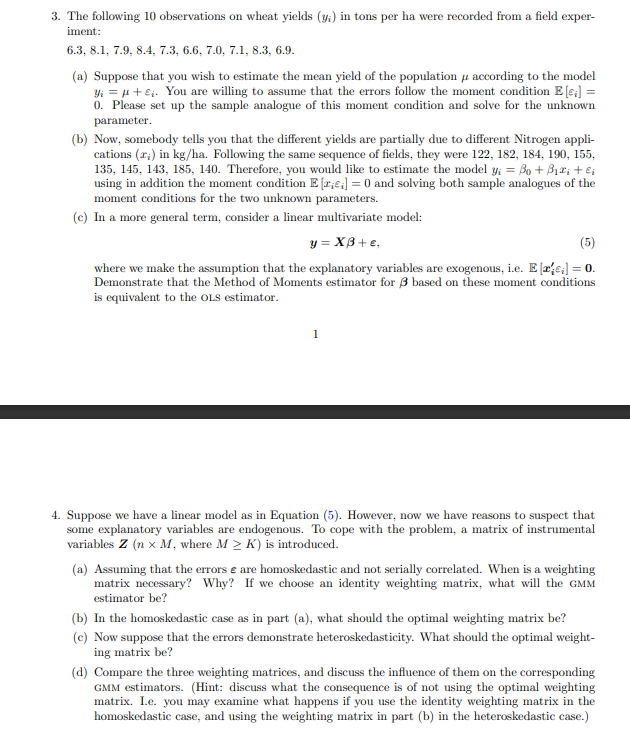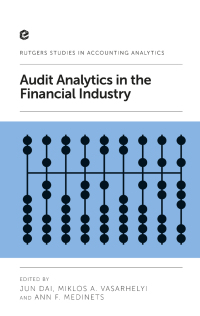equation5: y = X +
Please solve Question 4 with the equation shown from Question 3

3. The following 10 observations on wheat yields () in tons per ha were recorded from a field exper- iment: 6.3, 8.1, 7.9, 8.4, 7.3, 6.6, 7.0, 7.1, 8.3, 6.9. (a) Suppose that you wish to estimate the mean yield of the population i according to the model Yi = +. You are willing to assume that the errors follow the moment condition E [4] = 0. Please set up the sample analogue of this moment condition and solve for the unknown parameter. (b) Now, somebody tells you that the different yields are partially due to different Nitrogen appli- cations (Ti) in kg/ha. Following the same sequence of fields, they were 122, 182, 184, 190, 155, 135, 145, 143, 185, 140. Therefore, you would like to estimate the model yi = Bo + B12; + ei using in addition the moment condition E (27i] = 0 and solving both sample analogues of the moment conditions for the two unknown parameters. (e) In a more general term, consider a linear multivariate model: y=X8+, (5) where we make the assumption that the explanatory variables are exogenous, i.e. E [2] = 0. Demonstrate that the Method of Moments estimator for B based on these moment conditions is equivalent to the OLs estimator. 1 4. Suppose we have a linear model as in Equation (5). However, now we have reasons to suspect that some explanatory variables are endogenous. To cope with the problem, a matrix of instrumental variables 2 (nx M, where M > K) is introduced. (a) Assuming that the errors e are homoskedastic and not serially correlated. When is a weighting matrix necessary? Why? If we choose an identity weighting matrix, what will the GMM estimator be? (b) In the homoskedastic case as in part (a), what should the optimal weighting matrix be? (C) Now suppose that the errors demonstrate heteroskedasticity. What should the optimal weight- ing matrix be? (a) Compare the three weighting matrices, and discuss the influence of them on the corresponding GMM estimators. (Hint: discuss what the consequence is of not using the optimal weighting matrix. Le. you may examine what happens if you use the identity weighting matrix in the homoskedastic case, and using the weighting matrix in part (b) in the heteroskedastic case.) 3. The following 10 observations on wheat yields () in tons per ha were recorded from a field exper- iment: 6.3, 8.1, 7.9, 8.4, 7.3, 6.6, 7.0, 7.1, 8.3, 6.9. (a) Suppose that you wish to estimate the mean yield of the population i according to the model Yi = +. You are willing to assume that the errors follow the moment condition E [4] = 0. Please set up the sample analogue of this moment condition and solve for the unknown parameter. (b) Now, somebody tells you that the different yields are partially due to different Nitrogen appli- cations (Ti) in kg/ha. Following the same sequence of fields, they were 122, 182, 184, 190, 155, 135, 145, 143, 185, 140. Therefore, you would like to estimate the model yi = Bo + B12; + ei using in addition the moment condition E (27i] = 0 and solving both sample analogues of the moment conditions for the two unknown parameters. (e) In a more general term, consider a linear multivariate model: y=X8+, (5) where we make the assumption that the explanatory variables are exogenous, i.e. E [2] = 0. Demonstrate that the Method of Moments estimator for B based on these moment conditions is equivalent to the OLs estimator. 1 4. Suppose we have a linear model as in Equation (5). However, now we have reasons to suspect that some explanatory variables are endogenous. To cope with the problem, a matrix of instrumental variables 2 (nx M, where M > K) is introduced. (a) Assuming that the errors e are homoskedastic and not serially correlated. When is a weighting matrix necessary? Why? If we choose an identity weighting matrix, what will the GMM estimator be? (b) In the homoskedastic case as in part (a), what should the optimal weighting matrix be? (C) Now suppose that the errors demonstrate heteroskedasticity. What should the optimal weight- ing matrix be? (a) Compare the three weighting matrices, and discuss the influence of them on the corresponding GMM estimators. (Hint: discuss what the consequence is of not using the optimal weighting matrix. Le. you may examine what happens if you use the identity weighting matrix in the homoskedastic case, and using the weighting matrix in part (b) in the heteroskedastic case.)







